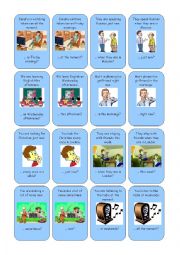
|
Go fish: present continuous and present simple 03
The third sheet of cards. The game is posted in four stages, because the file was too big to fit in one post.
A card game based on the principle of “go fish” that practices the use of the present continuous and simple tense. The set of cards consists of pairs. In each pair there is one card with a sentence in the present continuous and one card with a sentence in the present simple. Here is how it works:
1) The teacher deals 3 cards to each player. The player on the teacher´s left starts the game.
2) The player whose turn it is asks one other player for a card that would make a pair with one of her/his own cards. They can ask any player they want.
3) Asking is pursued as follows:
Let´s say that the player has a card with a sentence: “Alex is driving a bus at the moment.” Under the picture there is a time expression and a question mark: “... every day?” The card which makes a pair with this one has a sentence: “Alex drives a bus every day.” The player has to make a question by which he/she asks for this card: “Does Alex drive a bus every day?”
4) If the player who has been asked has the card she/he is asked for, i.e. in our example “Alex drives a bus every day,” he/she replies: “Yes, he does,” and hands the card over to the player who asked for it. The player who has received the card puts down the pair and asks further for another card that would make a pair with a card she/he is holding. If they don´t have any cards left, they draw a card from the deck. Again, he/she can ask any player they want. If the player who has been asked doesn’t have the card she/he is asked for, they reply: “No, he doesn’t.”
5) The player who has asked for a card draws a card from the deck and it is the turn of the player who has been asked. If the player who was asking draws the card they were asking for, they put down the pair and it is still their turn, i.e. they ask further. It he/she draws a card that makes a pair with another card in their hand, they have to wait until their next turn before they can put the pair down.
6) Let’s say that the player whose turn it is has a card with a sentence: “Alex drives a bus every day.” Under the picture there is a time expression and a question mark: “... now?” In that case she/he asks: “Is Alex driving a bus now?”, and the player who has been asked replies either: “Yes, he is,” or “No, he isn’t.” The contrast between the tenses helps students realize the difference between their meaning.
7) The game proceeds until there are no cards left. The player with the most pairs wins.
Level:elementary
Age: 9-17
Downloads:104 |
|
Copyright 22/4/2012 Tadeusz Szeryński
Publication or redistribution of any part of this
document is forbidden without authorization of the
copyright owner.
|


see more worksheets by [email protected]
|